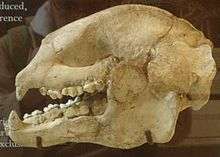Ailuropoda
| Ailuropoda | |
|---|---|
 | |
| The giant panda, the only extant species in the genus and subfamily. | |
 | |
| Ailuropoda fovealis skull | |
| Scientific classification | |
| Kingdom: | Animalia |
| Phylum: | Chordata |
| Class: | Mammalia |
| Order: | Carnivora |
| Family: | Ursidae |
| Subfamily: | Ailuropodinae |
| Genus: | Ailuropoda Milne-Edwards, 1870[1][2] |
| Type species | |
| Ailuropoda melanoleuca | |
| Species | |
|
†A. baconi | |
Ailuropoda is the only extant genus in the ursid (bear) subfamily Ailuropodinae. It contains one living and three fossil species of giant panda.[4]
Only one species—Ailuropoda melanoleuca—currently exists; the other four species are prehistoric chronospecies. Despite its taxonomic classification as a carnivoran, the giant panda has a diet that is primarily herbivorous, which consists almost exclusively of bamboo.
Giant pandas have descended from Ailurarctos, which lived during the late Miocene.[4]
In 2011 fossil teeth from over 11 mya found in the Iberian peninsula were identified as belonging to a previously unidentified species in the Ailuropodinae subfamily This species was named Agriarctos beatrix[5] (now Kretzoiarctos).[6]
Etymology
From Greek αἴλουρος "cat" + ‒́ποδος "foot". Unlike most bears, giant pandas do not have round pupils. They have vertical slits, as do cats' eyes. This has not only inspired the Latin name, but in Chinese the giant panda is called "large bear cat" (大熊猫, dà xióngmāo) and in Standard Tibetan, "cat bear" (byi-la dom).
Classification
- †Ailuropoda microta Pei, 1962[7][8] (late Pliocene)
- †Ailuropoda wulingshanensis Wang et alii. 1982[9] (late Pliocene - early Pleistocene)
- †Ailuropoda baconi (Woodward 1915)[10] (Pleistocene)
- Ailuropoda melanoleuca (David, 1869)[3]
- Ailuropoda melanoleuca melanoleuca (David, 1869)
- Ailuropoda melanoleuca qinlingensis Wan Q.H., Wu H. et Fang S.G., 2005[11]
Other pandas
Formerly, the red, or lesser, panda (Ailurus fulgens) was considered closely related to giant pandas. It is no longer considered a bear, however, and is now classified as the sole living representative of a different carnivore family (Ailuridae).
References
- ↑ Milne-Edwards, Alphonse (1870). "Note sur quelques mammifères du Thibet oriental". Annales des sciences naturelles, Zoologie. Ser. 5. 14 (10): 1.
- ↑ Milne-Edwards, Alphonse (1870). "Note sur quelques Mammifères du Thibet oriental". Comptes rendus hebdomadaires des séances de l'Académie des sciences. 70: 341–342.
- 1 2 David, Armand (1869). "Voyage en Chine". Bulletin des Nouvelles Archives du Muséum. 5: 13.
Ursus melanoleucus
- 1 2 Jin, Changzhu; Russell L. Ciochon; Wei Dong; Robert M. Hunt Jr.; Jinyi Liu; Marc Jaeger & Qizhi Zhu (June 19, 2007). "The first skull of the earliest giant panda" (PDF; fee required). Proceedings of the National Academy of Sciences. 104 (26): 10932–10937. doi:10.1073/pnas.0704198104. PMC 1904166. PMID 17578912. Retrieved 2007-06-19.
- ↑ J., P. Montoya, and J. Morales. "A New Species of Agriarctos (Ailuropodinae, Ursidae, Carnivora) in the Locality of Nombrevilla 2 (Zaragoza, Spain)." Estudios Geologicos 67.2 (2011): 187-191
- ↑ Abella, Juan, David M. Alba, Josep M. Robles, Alberto Valenciano, Cheyenn Rotgers, Raül Carmona, Jorge Morales, and Plinio Montoya. "Kretzoiarctos Gen. Nov., the Oldest Member of the Giant Panda Clade." PLOS ONE 7.11 (2012): 1-5.
- ↑ Pei, Wen-chung (1962). "Guǎngxī liǔchéng jù yuán dòng jí qítā shāndòng de dì sì jì bǔrǔ dòngwù" 广西柳城巨猿洞及其他山洞的第四纪哺乳动物 [Quaternary Mammals from the Liucheng Gigantopithecus Cave and Other Caves of Kwangsi] (PDF). Vertebrata PalAsiatica. 6 (3): 211–218.
- ↑ Pei, Wen-Chung (1963). "Quaternary Mammals From the Liucheng Gigantopithecus Cave and Other Caves of Kwangsi" (PDF). Scientia Sinica. 12 (2): 221–229.
- ↑ Wang, Linghong; Lin, Yufen; Chan, Shaowu; Yuan, Jiarong (1982). "Húnán shěng xīběi bù xīn fāxiàn de bǔrǔ dòngwù huàshí jí qí yìyì" 湖南省西北部新发现的哺乳动物化石及其意义 [Mammalian Fossils Found in Northwest Part of Hunan Province and Their Significance] (PDF). Vertebrata PalAsiatica. 20 (4): 350–358.
- ↑ Woodward, A. Smith (1915). "On the Skull of an extinct Mammal related to Æluropus from a Cave in the Ruby Mines at Mogok, Burma". Proceedings of the Zoological Society of London (III): 425–428. doi:10.1111/j.1469-7998.1915.tb07605.x.
- ↑ Wan, Qiu-Hong; Wu, Hua; Fang, Sheng-Guo (2005). "A New Subspecies of Giant Panda (Ailuropoda melanoleuca) from Shaanxi, China". Journal of Mammalogy. 86 (2): 397–402. doi:10.1644/BRB-226.1. JSTOR 4094359.